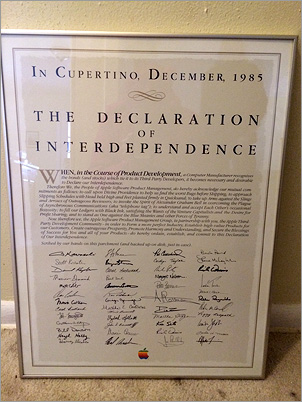Apple’s 1985 Declaration of Interdependence
Sometimes when you open your email, you receive unexpected news. And sometimes that news itself is of an unexpected find. Recently I got a note from a visitor to the Vintage Mac Museum describing a rather unique piece of Apple memorabilia:

I found this for my husband’s Christmas gift at a second hand store. It’s a poster titled The Declaration of Interdependence from 1985, and is in what I think is the original aluminum frame. It’s an awesome piece of Apple history […] I don’t know how many were made.
I wish second hand stores in my area had items like this!
I haven’t seen this poster before. I suspect it was a short lived creation. December 1985 was only a few months after Steve Jobs left the company, the Mac wasn’t selling well, and morale needed a boost. You don’t want to piss off your developers when growing a new platform, and Jobs was famous for his temper and demands. This tongue-in-cheek parody of the US Declaration of Independence shows both Apple’s cockiness and acknowledgement of reality in developing their products.
There isn’t much information online about the poster. The New York Times mentioned it briefly in a 1997 article, and the Computer History Museum has a copy in its archives. The full text reads:
In Cupertino, December 1985
THE DECLARATION OF INTERDEPENDENCEWhen, in the Course of Product Development, a Computer Manufacturer recognizes the bonds (and stocks) which tie it to its Third-Party Developers, it becomes necessary and desirable to Declare our Interdependence.
Therefore We, the People of Apple Software Product Management, do hereby acknowledge our mutual commitments as follows: to call upon Divine Providence to help us find the worst Bugs before Shipping; to approach Slipping Schedules with Head held high and Feet planted firmly in Quicksand; to take up Arms against the Slings and Arrows of Outrageous Reviewers; to invoke the Spirit of Alexander Graham Bell in overcoming the Plague of Asynchronous Communications (aka “telephone tag”); to understand and accept Each Other’s occasional Bozosity; to fill our Ledgers with Black Ink, satisfying the Wants of the Venture Capitalists and the Desire for Profit Sharing; and to stand as One against the Blue Meanies and other Forces of Tyranny.
Now therefore we, the Apple Software Product Management Group, in partnership with you, the Apple Third-Party Development community – in order to Form a more perfect Industry, Establish high-value Products for our Customers, Create outrageous Prosperity, Promote Harmony and Understanding, and Secure the Blessings of Success for You and all of your Products – do hereby ordain, establish, and commit to this Declaration of Our Interdependence.
Scribed by out hands on this parchment (and backed up on disk, just in case).
Pithy and Insightful! I don’t recognize most of the signatures, but the first one is Guy Kawasaki. He was an official Apple “evangelist” at that time, helping to rally customers and developers to the cause. I definitely suspect this was one of his projects. Certainly a fun thing to hang on your cubicle wall!
If any readers know more about the history of this item, please leave details in the comments.
Photo Credit: Katie Graham


Definitely a cool piece of Apple history — would look great on the wall of anybody’s Mac museum!
I have one of these documents. It was sent to me by Apple 3rd Party Product Developement after visiting their offices. As an early Mac owner, I invented a simple device to store, and protect the Mouse when not in use. The people at Apple asked me to visit and leave samples for them to use on their own Macs. One of the most memorable days of my life!
Unfortunately, my idea was pirated by a major computer products manufacturer, and I didn’t get the chance to visit Apple again. But, I’ve kept mementos like this, and copy from Macworld and A+. Advertising and reviews were found there on “Mouse-Trap”.